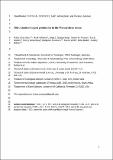Limited oxygen production in the Mesoarchean ocean
Abstract
The Archean Eon was a time of predominantly anoxic Earth surface conditions, where anaerobic processes controlled bioessential element cycles. In contrast to “oxygen oases” well documented for the Neoarchean [2.8 to 2.5 billion years ago (Ga)], the magnitude, spatial extent, and underlying causes of possible Mesoarchean (3.2 to 2.8 Ga) surface-ocean oxygenation remain controversial. Here, we report δ15N and δ13C values coupled with local seawater redox data for Mesoarchean shales of the Mozaan Group (Pongola Supergroup, South Africa) that were deposited during an episode of enhanced Mn (oxyhydr)oxide precipitation between ∼2.95 and 2.85 Ga. Iron and Mn redox systematics are consistent with an oxygen oasis in the Mesoarchean anoxic ocean, but δ15N data indicate a Mo-based diazotrophic biosphere with no compelling evidence for a significant aerobic nitrogen cycle. We propose that in contrast to the Neoarchean, dissolved O2 levels were either too low or too limited in extent to develop a large and stable nitrate reservoir in the Mesoarchean ocean. Since biological N2 fixation was evidently active in this environment, the growth and proliferation of O2-producing organisms were likely suppressed by nutrients other than nitrogen (e.g., phosphorus), which would have limited the expansion of oxygenated conditions during the Mesoarchean.
Citation
Ossa Ossa , F , Hofmann , A , Spangenberg , J E , Poulton , S W , Stüeken , E E , Schoenberg , R , Eickmann , B , Wille , M , Butler , M & Bekker , A 2019 , ' Limited oxygen production in the Mesoarchean ocean ' , Proceedings of the National Academy of Sciences of the United States of America , vol. 116 , no. 14 , pp. 6647-6652 . https://doi.org/10.1073/pnas.1818762116
Publication
Proceedings of the National Academy of Sciences of the United States of America
Status
Peer reviewed
ISSN
0027-8424Type
Journal article
Description
This study was funded by the University of Johannesburg; the National Research Foundation of South Africa [Department of Science and Technology Innovation Research Fellowship (F.O.O.), Grant 75892 (to A.H.), and the Centre of Excellence for Integrated Mineral and Energy Resource Analysis hosted by the University of Johannesburg]; the German Research Foundation Grant SCHO1071/7-1 under the DFG Priority Programme SPP 1833 “Building a Habitable Earth” (to R.S.); and the University of Lausanne. S.W.P. acknowledges support from a Royal Society Wolfson Research Merit Award and a Leverhulme Research Fellowship. A.B. acknowledges support from the Natural Sciences and Engineering Research Council of Canada Discovery and Accelerator grants.Collections
Items in the St Andrews Research Repository are protected by copyright, with all rights reserved, unless otherwise indicated.

